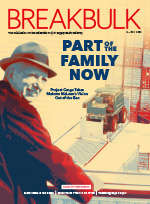Mar 11 | 2021
Innovation Will Surely Thrive in the Pandemic

 BREAKBULK ISSUE 3 PREVIEW CONTENT
BREAKBULK ISSUE 3 PREVIEW CONTENTBy Margaret Vaughan
It is said that necessity is the mother of invention, and during the Great Depression of the 1930s invention and innovation flourished – think Scotch Tape, electron microscopes and Spam.
So, during this current time of enforced isolation, I’m wondering what sorts of innovative ideas and products will emerge. Without the distraction of meetings, colleagues, office politics and general coffee room discussions, I would think that innovators will come up with some incredible stuff.
Innovation invariably creates winners and losers. The introduction of the automobile shifted consumer demand away from trains much like the railways had, in decades prior, displaced canals and waterways as major forms of transportation. The result was job offers for some workers and pink slips for others. Nicholas Carr, in his book The Glass Cage, Automation and Us, put it succinctly: “There is no economic law that says that everyone, or even most people, automatically benefit from technological progress.”
There are certainly some transportation innovations in progress. A startup company called Xwing has completed what they claim to be the “world’s first fully autonomous air cargo flight,” using a Cessna plane that will ensure more cost-effective operations for logistics companies. Xwing’s Autoflight System retrofits existing aircraft by integrating onboard flight control systems that allow the aircraft to navigate, take off and land autonomously. The vehicles can also be optionally piloted. Airbus is working on pilotless commercial planes.
Meanwhile in the UK city of Coventry, a temporary airport for flying cars is being built as a proof of concept of a zero-emissions hub for future modes of travel. Electric vertical take-off and landing vehicles are being suggested as a low-carbon way to ease congestion as people travel between urban centers. At the January 2020 Consumer Electronics Show in Las Vegas, Uber and Hyundai unveiled a full-size model of a planned air taxi. Called the S-A1, it will be 100 percent electric, take off vertically, then transition to wing-borne lift; it can carry four people at speeds of up to 180 mph at an altitude of between 1,000 and 2,000 feet.
Ship Autonomy Progress
Elsewhere, companies involved in the “Designing the Future of Full Autonomous Ship Project” will carry out field testing of crewless domestic container ships working toward the commercialization of autonomous ships by 2025. The members expect that this demonstration of the crewless operation of ships in congested waters navigating over long distances and the early implementation of autonomous shipping will improve their international competitiveness.
The sensors and communication technology already exists to enable ships to safely navigate to a destination while avoiding collisions. Kongsberg is among those building situational-awareness systems that fuse imagery from cameras with lidar, radar and satellite uplinks. This data can either be sent to a skipper who operates the ship remotely from shore, or to on-board computers that entirely replace the human element of control.
Autonomous and remotely operated ships will be more efficient and cheaper to run for ship owners. Since the new generation of ships won’t be manned, there’s no need for crew quarters, galleys, water and sewage, and other amenities that take up space, weight and energy. Crewless ships will have less drag, consume less fuel, and be able to carry more cargo per voyage, resulting in significant economic and environmental gains.
 It’s interesting that DARPA, the Pentagon’s research agency, wants to design a ship from scratch to be fully automated. The project, known as No Manning Required Ship, or NOMARS, aims to create a ship where every inch is available – or not wasted on human beings, depending on how you look at it. Which begs the question what will that do to the U.S. Merchant Marine?
It’s interesting that DARPA, the Pentagon’s research agency, wants to design a ship from scratch to be fully automated. The project, known as No Manning Required Ship, or NOMARS, aims to create a ship where every inch is available – or not wasted on human beings, depending on how you look at it. Which begs the question what will that do to the U.S. Merchant Marine?A taste of the future. “Open the pod bay doors, HAL.”
Margaret J. Vaughan has more than 30 years’ experience in all facets of supply chain management.
Image credit: Shutterstock

